
Practitioners Unveil:
The Fault Zones in
Project Business
This page: Intro: Fault Zones ••• Conclusion: Respect Matters ••• The Research Question ••• Survey & Results ••• Digging Deeper ••• Comments by Participants

Study: The Fault Zones in Cross-Corporate Projects
Summary: A study with 346 survey participants revealed a surprising insight for Project Business: While in smaller cross-corporate projects, the root sources of trouble are more frequently found inside the organizations involved, in larger projects, these fault zones are shifting to the interfaces between the organizations. In these projects, practitioners should take special care of how the organizations involved communicate and cooperate and how much respect they show for each other.
Reference: Project Business Foundation (2024). Practitioners Unveil: The Fault Zones in Project Business, June [Online]. Available from: https://project-business.org/research/the-fault-zones-in-project-business (Accessed: ## #### 202#).
How to avoid trouble in Project Business:

1. Conclusion: Respect Matters
As shown in detail below, the study revealed a surprising insight about the fault zones in Project Business: While in smaller projects, trouble more frequently originates inside the organizations involved, the fault zone shifts in larger projects to the interfaces between the organizations.

To some degree, this is demonstrated in the realm of Project Business by the many organizations that rightly understand how careful selection of customers and contractors is key to avoiding potential issues.
Indeed, vendors and service providers sometimes opt not to engage with certain buyers if they anticipate excessive complications outweighing the potential profits. Similarly, buyers exercise caution when choosing project contractors to prevent costly disruptions to their projects and business operations.
Regrettably, however, the dynamics of success and failure at the interfaces between organizations involved are often disregarded.
Each entity possesses distinct business interests, corporate cultures, and dominant personalities, which may not always align seamlessly. Too often, this leads to small disagreements and dissatisfaction increasing and becoming worrisome for the project and the parties involved. Then, minor disputes can escalate into substantial conflicts for the project and involved parties.
It is, therefore, imperative to prioritize a more rigorous examination of the interfaces and interactions between the parties involved in the project. This should encompass a thorough exploration of the interpersonal, commercial, and legal dimensions and the risks, but also the potential for conflicts, in these areas.
What Can Practitioners Take Home from the Study?
As the project grows in size and involves more people and organizations, it becomes increasingly critical to pay attention to the risk of trouble caused by poor respect, communications, and cooperation between the parties under contract. Indeed, embracing mutual respect and demonstrating an unwavering commitment to collaborative cross-corporate teamwork is indispensable for ensuring the success of any project and the satisfaction of all stakeholders involved, and the larger the project is, the more this will influence its success.
What about Mega Projects?
This observation may also provide an answer to a commonly discussed question: Why do so many large projects and mega-projects fail to deliver on scope, time, budget and stakeholder satisfaction? Insufficiently understood and managed business interfaces between the organizations involved provide a plausible explanation. Each party does its job, but they do not team up for the benefit of the project.
More study in this field may be helpful for the benefit of major projects.

2. The Research Question: Where Does Trouble Originate?
A critical question in Project Business
In a previous study, respondents identified the major reasons for conflicts in cross-corporate projects:
- Diverging Business Interests
- Diversity of cultures, legal systems, and moral compasses
- Incompatible Egos and uncooperative behavior
Now, this study addressed the question: Where do these conflicts and other sources of trouble originate? Are the fault zones in Project Business on the customer side, the contractor side, or at the interfaces between the parties involved?

Fault Zones in Project Business May Be…
On the Customer Side:
The project customer refers to the individual or organization that initiates the project and provides the requirements and funding. Issues originating from the project customer can include:
- Unclear or Changing Requirements:
Customers may not have a clear vision of their needs or may change their requirements frequently, leading to scope creep and project delays. - Unrealistic Expectations:
Customers might have unrealistic expectations regarding the timeline, budget, or outcomes, creating pressure and potential conflicts. - Lack of Involvement:
Insufficient engagement or communication from the customer can lead to misunderstandings and misaligned objectives. - Financial Constraints:
Budget cuts or delayed payments can hinder the project’s progress and cause resource shortages.
On the Contractor Side:
The project contractor is responsible for executing the project according to the customer’s requirements, who is also paying the contractor. Problems related to the project contractor can include:
- Lack of Expertise:
Contractors may lack the necessary skills or experience to deliver the project successfully, leading to quality issues and delays. - Resource Shortages:
Insufficient human, technological, or financial resources can impede project progress. - Poor Project Management:
Ineffective planning, scheduling, and risk management can result in missed deadlines and cost overruns. - Communication Issues:
Inadequate communication within the contractor’s team can lead to misunderstandings and errors.
At the Customer-Contractor Interface:
The interface between the customer and contractor is crucial for ensuring that both parties are aligned and working towards common goals. Problems at this interface can include:
- Miscommunication:
Differences in terminology, assumptions, or expectations can lead to miscommunication and misunderstandings. - Contractual Disputes:
Disagreements over contract terms, deliverables, or performance standards can result in conflicts and delays. - Cultural Differences:
If the customer and contractor are from different cultural backgrounds, differences in business practices and communication styles can create friction. - Trust Issues:
Lack of trust can hinder collaboration and openness, leading to a defensive or adversarial relationship.
At the Interfaces between Contractors
Even small projects often involve multiple contractors working together, and the interfaces between these contractors can be a source of problems. These issues include:
- Coordination Challenges:
Ensuring that all contractors are working in sync and meeting their interdependent deadlines can be challenging. - Conflicting Priorities:
Different contractors may have their own priorities and agendas, which can conflict with the overall project goals. - Information Silos:
Contractors might withhold information or fail to share important updates, leading to a lack of coordination and increased risk of errors. - Accountability Issues:
Determining responsibility for problems can be difficult when multiple contractors are involved, leading to finger-pointing and delays in resolving issues.

3. The Survey and Its Results
The survey collected responses between March 2023 and June 2024. It had 346 responses of which 338 responses were used for the study.
The participants were found on LinkedIn and through private contacts. The survey had four questions and associated answers:
Question 1:
Typically, what is true for the projects you manage?
- My projects are internal and performed by the organization’s employees.
- I’m in project business. My position is on the customer side.
- I’m in project business. My position is on the contractor side.
- Other (please specify)
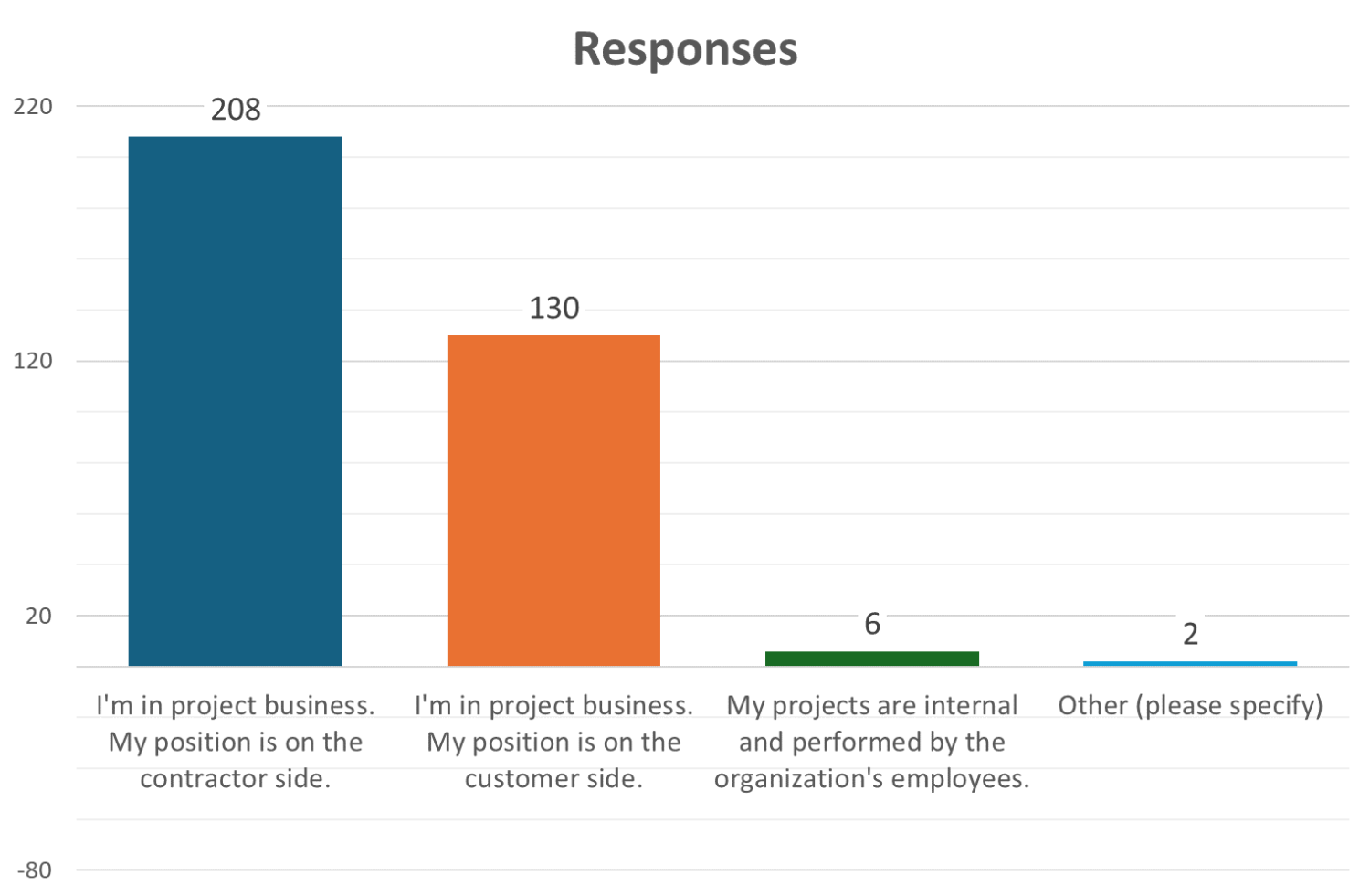
Note:
Of the 346 respondents, 8 selected “internal” or “other.” As they were not within the survey’s target audience, their responses were not used for the study.
Question 2:
Occasionally, you may have experienced troubled projects, even crises. Where did the trouble originate from?
Please rank on a scale from 1 (most frequent) to 4 (least frequent).
- The project was troubled by different business interests, cultures, etc. between customer and contractor(s).
- The project was troubled by shortcomings inside the customer organization.
- The project was troubled by shortcomings inside the contractor organization(s).
- The project was troubled by differences in business interests, cultures, etc. between contractors.
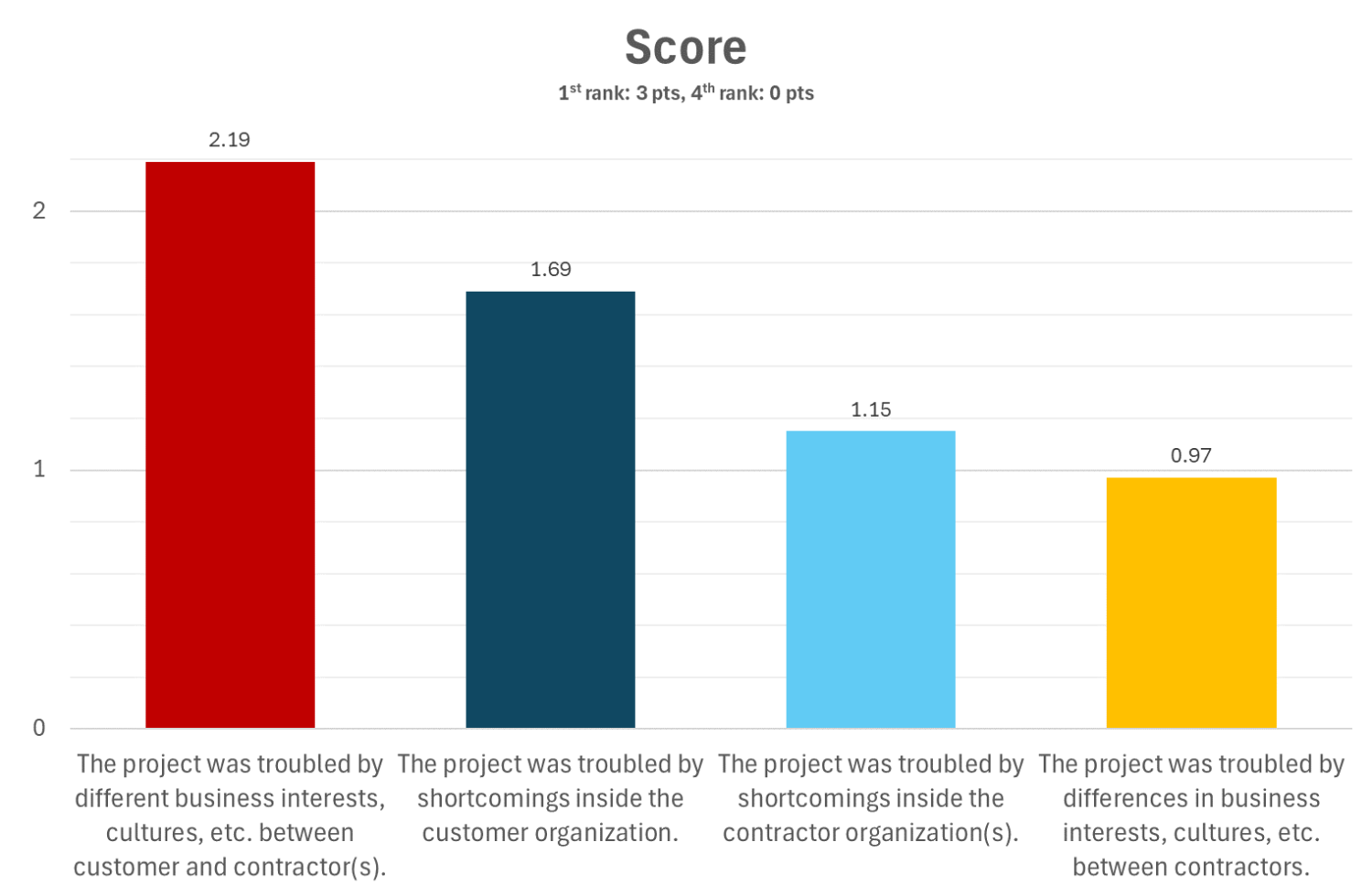
Note:
Participants were instructed to rank the four answers. Each time an answer was in top position, it received 3 points, the second position received 2 points, the third position 1 point, and the last position, representing the least frequency, received zero points.
The diagram illustrates the average values of the results for each option at the conclusion of the survey.
Question 3:
How many people are actively involved in your current or latest project (including customer and contractor staff) over the duration of the project?
- 1-10
- 11-100
- 101-1,000
- 1,001-10,000
- >10,000
- I don’t know

Question 4:
Please select your home region.
- Africa
- Asia
- Australia & New Zealand
- Europe (EU & non-EU)
- Latin America
- Middle East
- USA, Canada
- Other (please specify)
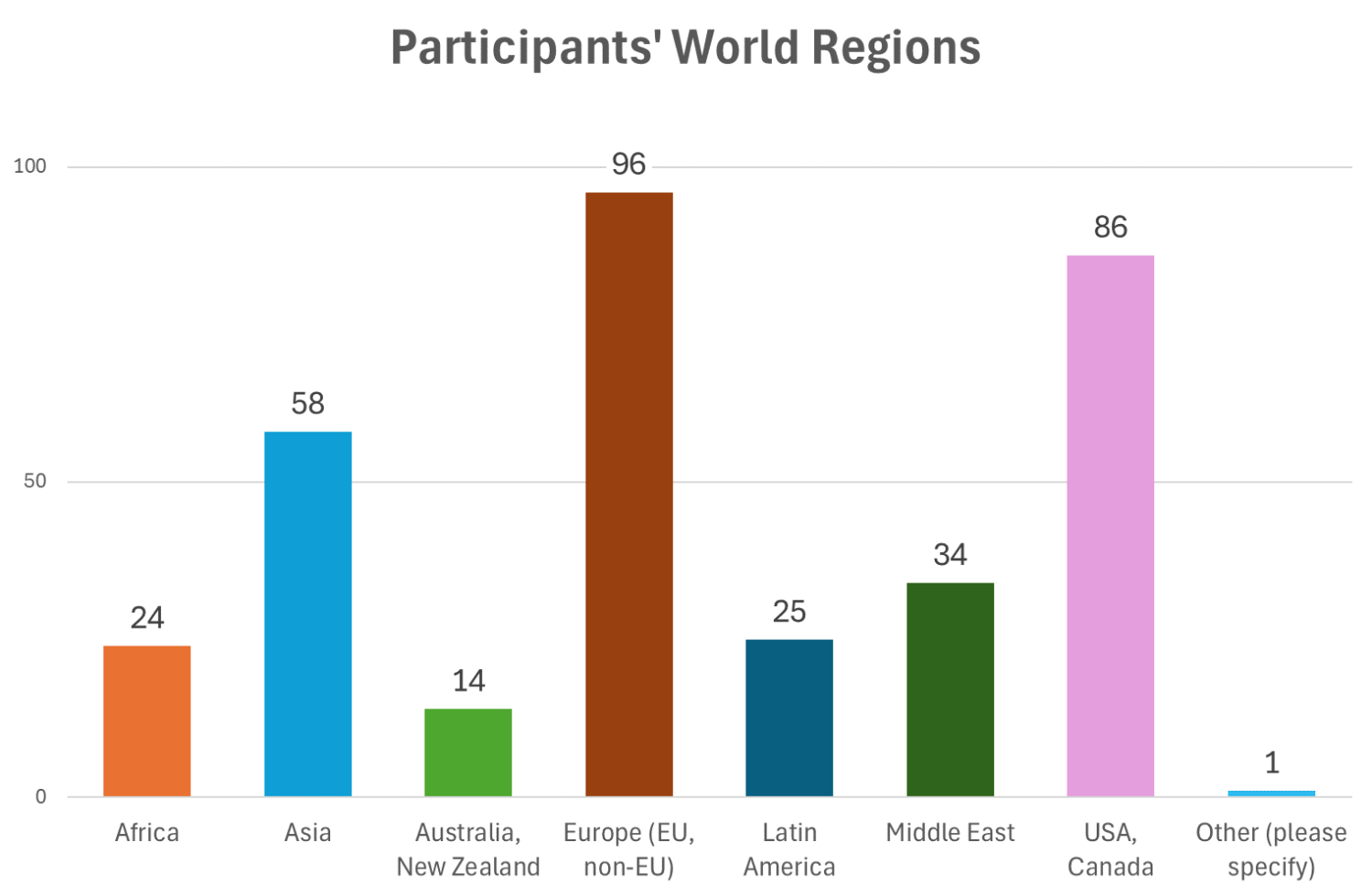

4. Digging Deeper
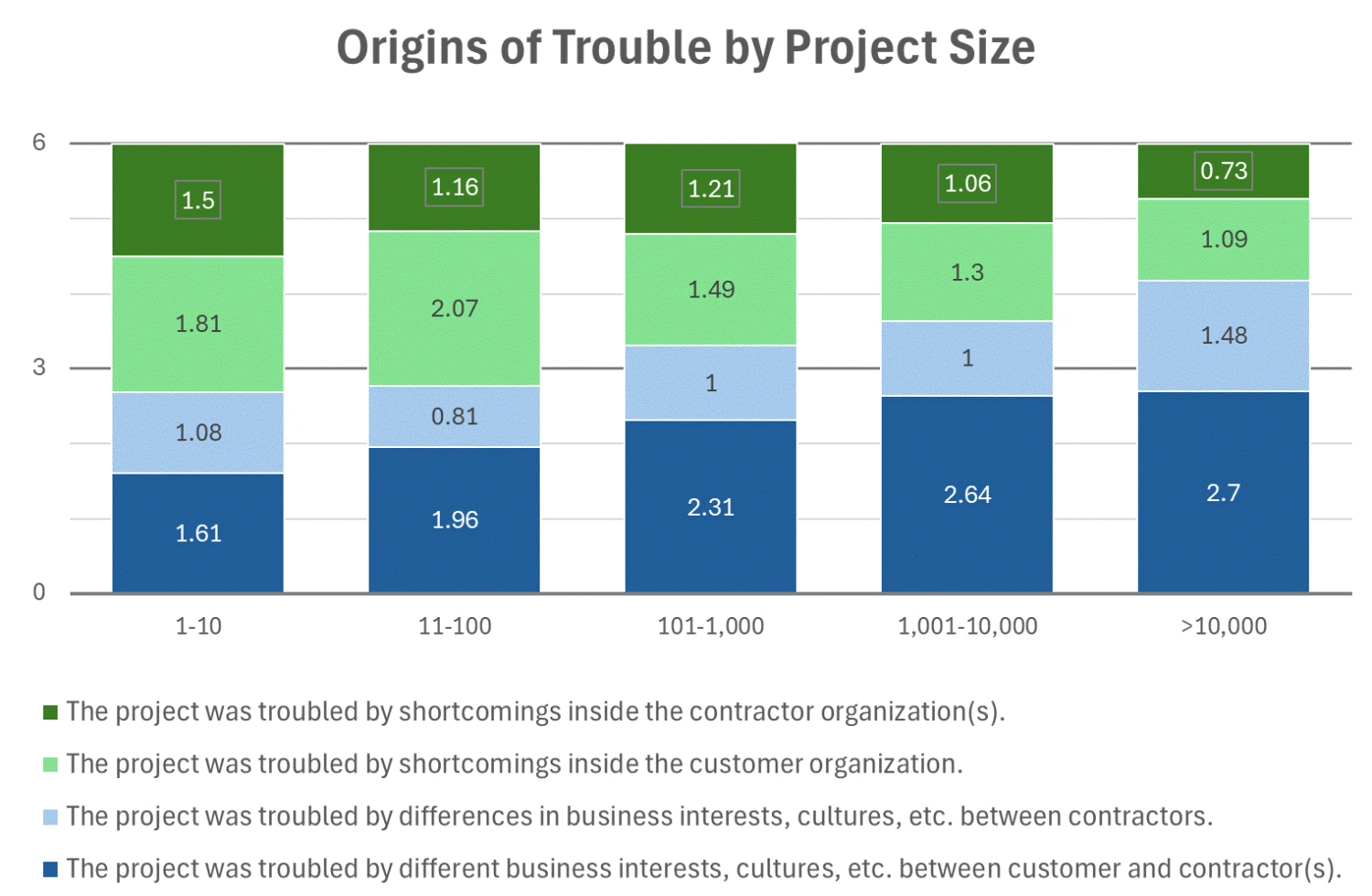
A question that the study seeked to answer is whether the risk of trouble in Project Business is higher inside the participating organizations or at the interfaces between them. The result was surprising.
The diagram shows that the answer differs for small and large projects.
- Reportedly, in small projects with up to 100 individuals throughout their lifecycle, trouble more commonly originates within the participating organizations (green bars).
- As project size increases, the origin of issues reportedly shifts from within the participating organizations to the interfaces between them (blue bars).
Two more observations are consistent across all project sizes:
- The customer organization (light green) scores higher than the contractor organization (dark green). More trouble reportedly originates inside the buying party than in the party that delivers and serves against money.
- The customer-contractor interface (dark blue) is more critical than the interfaces between the contractors (light blue). In medium to large projects, it is the biggest source of trouble.
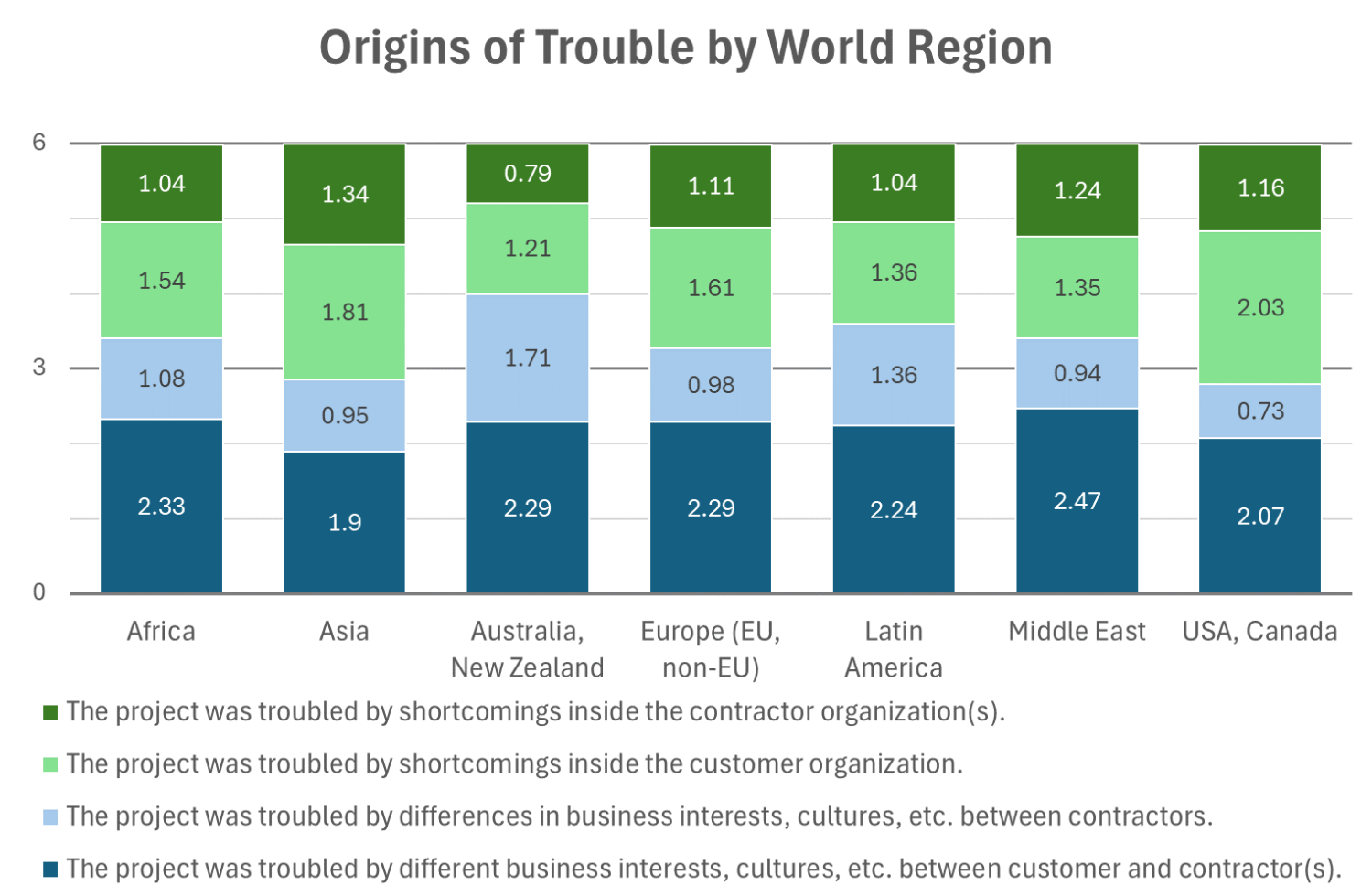
The diagram confirms the two additional observations as valid for all world regions:
- The customer organizations have a higher score as a source of trouble than the contractor organizations.
- The interfaces between the contractors seem to be less problematic than the interfaces between the customer and contractor(s).
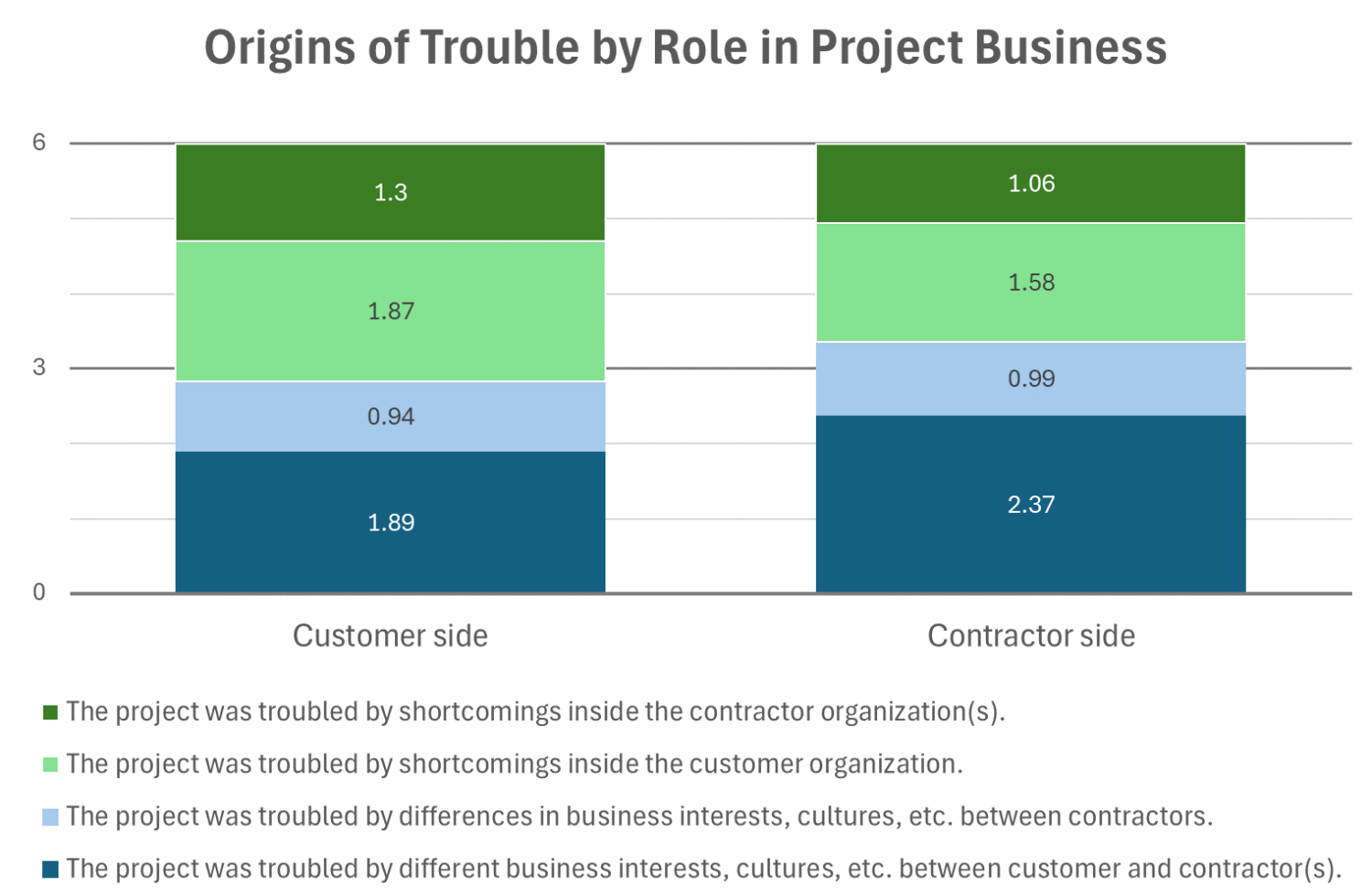
Despite some differences in the responses by customer-side and contractor-side project managers, they also share basic perceptions:
- The customer organizations are more often the source of trouble than the contractor organizations.
- The interfaces between the customer and its contractors are more often troublesome than the interfaces between the contractors, which seem, in contrast, more ‘peaceful’.
- The customer-contractor interface is the most critical factor of trouble in cross-corporate projects.

5. Comments by Survey Participants
The study was designed to allow participants to finish the survey in under a minute. Or they could spend more time and add personal notes. Here is a selection of some of these comments.
These questions make one deeply reflect on the current process.
Thank you, Oliver. We need this information.
It’s an interesting topic; would like to be a part of it & contribute in some capacity in the future.
Other than this the trouble in project business comes from incompetent team and lack of organizational structural development
Very real issue also in regards to the worldwide crises in staff, material shortage inflation, etc
Keep up the great work
It’s an interesting topic; would like to be a part of it & contribute at some capacity in the future.
Very useful questions.
Thank you for illuminating the specific complexities and concerns of project business.
For #2, it was difficult to rank the 2nd and 3rd choice because issues come from both sides.
Problems are generally caused by unrealistic expectations and poor communication between customer and service provider.
Thank you for the opportunity to help the community.
Biggest trouble and at the same time biggest risk according to my experience (over 20y of pm experience) is the achievement of the budget on contractor (our) side where a lump-sum was fixed in a contract, but there is a lot of engineering involved in the project.
The success of the project totally depends on how well both the client and contractor teams trust and support each other.
Mostly, the problem came from the contractor side due to different cultures
I observed that troubled projects are mostly due to customers with no project culture and in the absence of senior executive buy-in.
I see problems at the high level, e.g., unreasonable risk passed to contractors, also low-level issues, such as incorrect assumptions in design details.
Key contributors to project failure begin with poor business cases used to justify the project, followed by underestimating project complexity, poorly developed success criteria, and insufficient / inadequate risk management,
Scheduled tasks with no float are hard to comply with, hence generating lags…
Biggest challenge is the scope of the contract. Meaning, getting it correct for the particular NEC4 contract you are using.
Question 2 see my replies: 1. Sales stage – not paying attention to specifications and promising too much as contractor. 2. Customer – contradictory requirements and specifications, lack of understanding of his own requirements. 3. Project communication throughout the project
I have done an analysis for projects going sour and one of the prime reasons was inappropriate planning, which led to issues in delivery stage, variations, unhappy stakeholders etc.
I believe that troubled projects mostly result from lack of clarity & alignment. Clarity – of scope & expectations, leading to conflicting priorities across stakeholders. Alignment – across various stakeholders on their positions vis-a-vis the various project scope elements & context elements.
Fundamentally, the topics in this survey have 1 major contributor, lack of clear communication.
Unclear requirements on the customer side cause most projects to fail.
As a contractor you serve the customer at their whim essentially. Typically it won’t be the customer that gets fired if there are issues on the project. So as the contractor we often are victims of very POOR leadership and indecision by the customer that we then have to try to make up for.
I inherited a ‘dumpster fire project’ where relationships between stakeholders had deteriorated, and project creep had set in. My resolution process involved re-identifying project objectives, contractor responsibilities, agreed tasks, and timescales. This was followed by verbal recognition of task achievements before moving on to the next task, and so on.
Problems often occur in projects originating from unpreparedness in terms of planning and initiated by unpreparedness on the part of the customer, especially in the team of personnel who will be directly involved in the project.
Most problems in my current project is arising due to tech debt and the appetite of the customer for change into modern system
In my experience, most of the problems have the origin in an organization who “sells” a huge culture of Project Management when they have none. Then you have conflicts from the beginning.
There are two primary factors I recognized where trouble is triggered: 1. Customers get more and more knowledgeable about what they can request from Service Providers. Contracts get more and more detailed. Providers, on the other side, tend to commit more and more to service quality, which they know they can’t deliver, just in order to close a deal. 2. At least in Germany, I recognize an IT staff shortage. This is one of the reasons why service providers, even if they want to deliver quality, have difficulties to satisfy customer needs.
